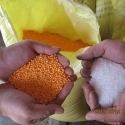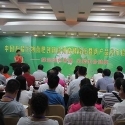03 Apr 2013
Fertilizer consumption and soil nutrient status in SE China

Abstract:The consumption of commercial potash and compound fertilizers were increased significantly in SE China in last two decades. Farmland soil available N and P balances are positive in the region, while the soil available K balance was negative. Field trial results showed that the winter crops production were more depend on additional commercial fertilizers and the value of fertilizer contribution rates (FCR) were higher than summer crops. Summer crops and paddy rice could use more soil indigenous nutrients. Usually grain crops obtained better agronomy efficiency (AE) than oil and fiber crops, while cash crops and vegetable obtained better economic benefit from potash application.
Commercial fertilizers consumption
Table 1 and Table 2 showed that total fertilizer consumption was increased significantly in most of the provinces in southeast region of China in the past two decades. All of this increase was come from potash and compound fertilizers. The total NPK fertilizer consumption in this region increased 8.5% from 2000 to 2005 and 9.4% from 2005 to 2010, while potash consumption increased 21.6% from 2000 to 2005 and 8.2% from 2005 to 2010. The ratio of fertilizers’ N: P2O5: K2O changed from 100: 31: 19 in 2000 to 100: 32: 25 in 2010. Although this ratio is more close to the balance, but we still have a long way to go. The ideal ratio should be 100: 42: 35 in this region as recommended by experts.
At the same time, the total farmland area decreased 5.74% (from 26,804,400 ha in 2000 to 25,267,000 ha in 2010), especially in the provinces of Shanghai, Fujian and Zhejiang. If we take the farmland area decrease into consideration, these commercial fertilizers increase rates in these periods are quite significant.
Table 1 Commercial fertilizers consumption in southeast China (×1,000 t)
Table 2 Commercial fertilizers consumption by province in SE China (2000-2010)
Farmland soil nutrient balances
Due to more and more high yielding crop cultivars have be used, crops mined more nutrient from farmland soil in last 3 decades. Soil available potassium was exhausted consequently. Table 3 presents farmland soil NPK nutrient status in three provinces in southeast China. In this period, the soil available N and P balances are positive (more input than output), while the soil available K balance in the provinces was negative. This situation was quite common in all of these regions no matter the landform is plain or mountainous (Table 4). Potassium has become one of the most important nutrient limiting factors for long time in these regions.
Table 3 Farmland soil nutrient balances in 3 provinces of southeast China (2000-2010)




